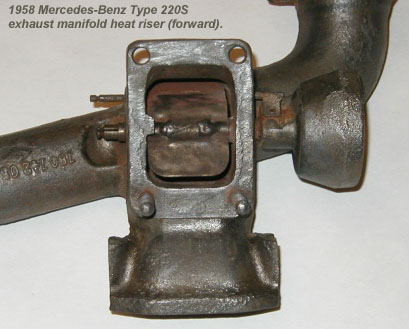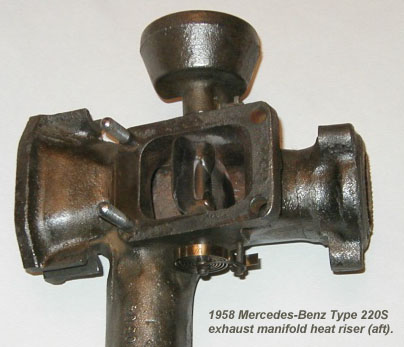
David Steckel /
dcandk@rocketmail.com / Springfield, Ohio
1958 Type 220S sedan / December 31, 2004
The two photos below show the forward and aft heat riser assemblies respectively from a 1958 Mercedes-Benz Type 220S Ponton sedan. When initially removed from the engine, both flapper plates were "welded" in place by exhaust carbon. To remedy this condition, both units were soaked in a white vinegar bath for over four weeks. The mild acidity in the vinegar dissolved the carbon to the point where the flaps could be turned by hand. It also removed most of the grease and rust from the manifold itself. A great home remedy.

Photo 1.
Exhaust manifold heat riser (forward).
Flap is shown in the "hot" (closed) position.

Photo 2. Exhaust manifold heat riser (aft) with bi-metallic "thermospring"
attached.
Flap is shown in the "cold" (open) position.
If you do not wish to remove the manifold from the engine, the process can be accomplished with penetrants, such as PB Blaster. Better results have been noted by using a Mopar Heat Riser squirt, available at Chrysler dealers. This (again) is a time consuming process of squirting both the inner and outer shaft points and physically moving the counterweight in hopes of breaking them loose. We're talking a couple of weeks of daily attention, depending on the rigidity of the flaps.
The thermospring (153-143-00-10) and the retaining clip (186-993-01-25) are not shown mounted on the two pins of the pictured forward unit so the flap could be positioned in a closed ("hot") manner.
In the "cold" position, (see Photo 2 – aft heat riser) the flaps deflect the exhaust gases up onto the intake manifold, which is mounted to the (2) studded rectangular plate. This heats the intake fuel/air mixture to provide a more volatile combination(?). Once the system begins to warm, the thermosprings weaken and the exhaust gases push (close) the flap to allow the exhaust gases to exit the manifold directly. One can tell if the flap is in the cold position by noticing that the counterweights are flopped towards the (right) fender.
Some owners have debated removing these risers, due to the constant maintenance required to keeping them in a working state. They were originally installed for a reason (as noted above). They were not omitted in cars that were sold to the tropics or other hot climates. Mercedes could easily have done so, but didn't. M-B must have seen a value for risers in all circumstances. It is nice when original equipment can be made to work as intended, providing satisfaction for the owner.
Illustration 1. Type 190 / Catalog B / 1958 / Table 7 / exhaust manifold
Illustration 2. Type 219 / Catalog B / 1958 / Table 7 / exhaust manifold
Illustration 3. Type 220S / Catalog C / 1958 / Table 7 / exhaust manifold
Type 190 / Catalog B / Table 7 (illustration) courtesy: Doug Broome
Type 219 / Catalog B / Table 7 (illustration) courtesy: Doug Broome
Type 220S / Catalog C / Table 7 (illustration) courtesy: Jeff Miller
Created: December 30, 2004 / Jeff Miller
Last Update:
April 12, 2016
© www.mbzponton.org